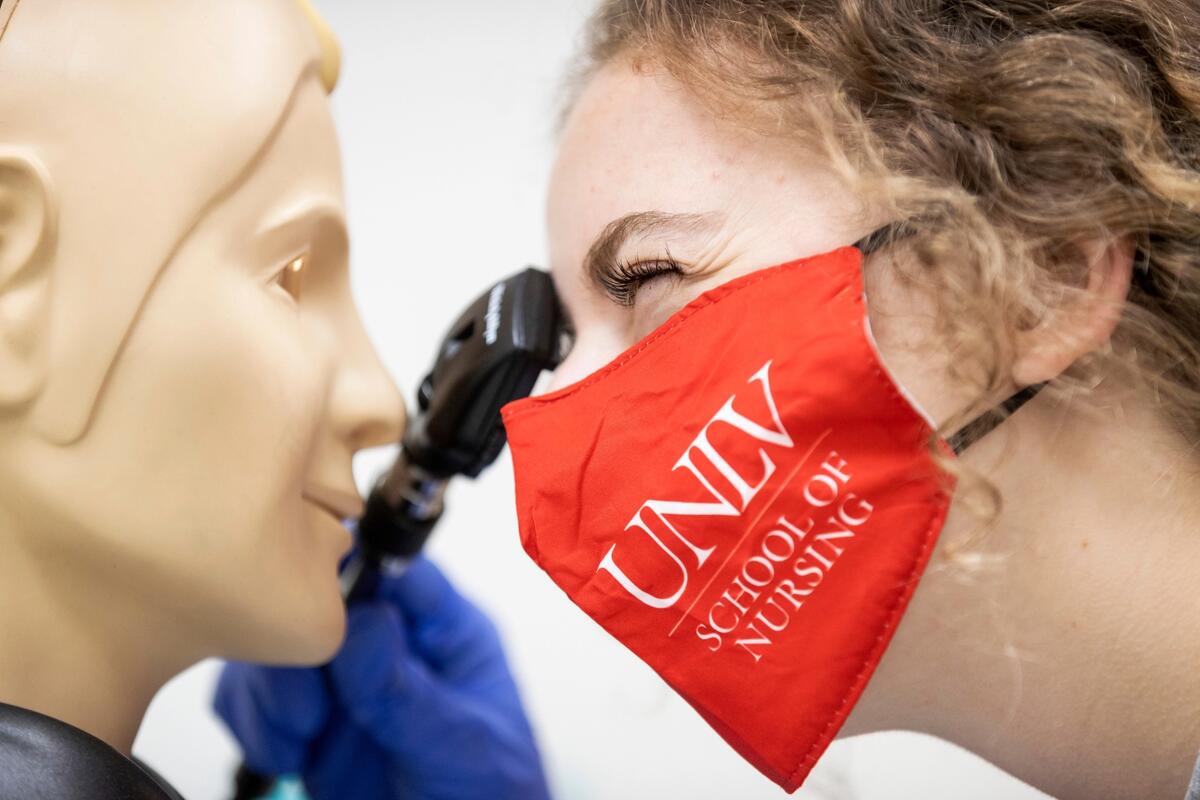Ever had your blood drawn at the ER? The nurses seem like they've placed the tourniquet, found a good vein, and quickly inserted the needle a million times. You can’t help but wonder about that first time they drew blood on a patient — did they leave with an arm full of bruises?
Enter the Clinical Simulation Center of Las Vegas (CSCLV) — a place between didactic learning of the classroom and clinical instruction with a live patient. The CSCLV provides students with a chance to practice on high-tech, responsive manikins.
Now, thanks to a $400,000 federal appropriation, part of the $5.38 million in funding that UNLV received to enhance educational resources, the CSCLV can expect upgrades to the facility’s simulation equipment.

Professor-in-residence Leland "Rocky" Rockstraw and Director of Federal Government Affairs Jason Wasden worked to secure the funding that for new state-of-the-art simulation equipment to train nursing students in a controlled, realistic environment.
Rockstraw says, “This equipment is going to help the faculty and administration of the school focus less on resources and more on the student teaching and student outcomes.”
Learning to Work Within a Healthcare Team
With five high-fidelity simulation labs, three clinical skills labs, a surgical simulation suite, and 12 standardized patient rooms, students hone every skill in the book: from fundamentals like checking vital signs and drawing blood to complex situations like surgery or labor and delivery.
Though the most important skills learned, Rockstraw says, are ones not always easy to directly teach. “When we think about simulation and improving patient care, the competencies or the skills are not health care related, but they're teamwork related: communication, leadership, situational monitoring, and mutual support.”
He notes that having a good foundation of teamwork with other medical professionals decreases errors and leads to an increase in positive patient outcomes.
Leading in Nursing Education
The quality of nursing education at UNLV continues to speak for itself, with UNLV Nursing maintaining a strong position at the top of the U.S. News & World Report rankings. The college’s traditional master’s and doctoral programs were ranked in the top 100 in 2024, and online programs — which offer generalist and specialty master’s tracks in nurse educator preparation, family nurse practitioner, nurse midwifery, and psychiatric mental health — have ranked within the top 30 each year since the publication began rating online nursing programs in 2012.
Part of the program’s success can be attributed to UNLV’s approach to using the CSCLV. “UNLV is advanced, integrating simulation across the curriculum — from a nursing student's first semester through their final semester — since 2010. Many nursing programs struggle to give students one or two experiences. And we have some courses where our students have two to four experiences in one class,” Rockstraw says.
Not only that, but UNLV is one of the first universities to implement full-student participation in the simulations. “Typically you do a simulation with eight nursing students,” explains Rockstraw. “Two students participate in the simulation and six sit and watch. We wanted to get them involved.”
That's when one of Rockstraw's colleagues had an idea for how to incorporate all students into the simulation. Lisa Nicholas, assistant professor and simulation education director, proposed having two students in the control center to operate the settings of the simulation, adding a third student in the simulation to act as a supervisor to the two practicing students, and so on.
“Instead of assigning two students to a simulation, at UNLV we’re assigning all eight," he says. "They're integrated in each and every simulation, and they're practicing getting better in their different roles. I don't believe anyone is doing that across the country.”
Better Preparation for Entering the Nursing Workforce
There is an impending demand for nursing professionals, and a large portion of current nursing educators are nearing retirement, according to Nicholas.
Interim School of Nursing Dean Imelda Reyes emphasized that the new funding will help UNLV bolster Nevada’s nursing workforce. According to Reyes, 90% of UNLV nursing graduates choose to stay in state.
And by providing additional resources that improve upon the education UNLV nursing students are already receiving, Rockstraw says, patient outcomes and safety will also continue to improve.
“Simulation allows students to practice, making them more prepared to care for patients," he says. "Upon graduation, they are better equipped, which decreases medical errors, improves patient outcomes, and ensures a higher quality of care.”



